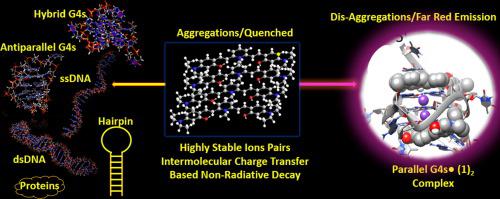Bioorganic & Medicinal Chemistry ( IF 3.5 ) Pub Date : 2021-02-16 , DOI: 10.1016/j.bmc.2021.116077 Anup Pandith 1 , Upendra Nagarajachari 2 , Ravi Kumara Guralamatta Siddappa 1 , Sungjin Lee 3 , Chin-Ju Park 3 , Krishnaveni Sannathammegowda 2 , Young Jun Seo 1

|
Herein we report simple pyridinium (1–3) and quinolinium (4) salts for the selective recognition of G-quadruplexes (G4s). Among them, the probe 1, interestingly, selectively discriminated parallel (c-KIT-1, c-KIT-2, c-MYC) G4s from anti-parallel/hybrid (22AG, HRAS-1, BOM-17, TBA) G4s at pH 7.2, through a switch on response in the far-red window. Significant changes in the absorption (broad 575 nm → sharp 505 nm) and emission of probe 1 at 620 nm, attributed to selective interaction with parallel G4s, resulted in complete disaggregation-induced monomer emission. Symmetrical push/pull molecular confinements across the styryl units in probe 1 enhanced the intramolecular charge transfer (ICT) by restricting the free rotation of C C units in the presence of sterically less hindered and highly accessible G4 surface/bottom tetrads in the parallel G4s, which is relatively lower extent in antiparallel/hybrid G4s. We confirm that the disaggregation of probe 1 was very effective in the presence of parallel G4–forming ODNs, due to the presence of highly available free surface area, resulting in additional π-stacking interactions. The selective sensing capabilities of probe 1 were analyzed using UV–Vis spectroscopy, fluorescence spectroscopy, molecular dynamics (MD)–based simulation studies, and 1H NMR spectroscopy. This study should afford insights for the future design of selective compounds targeting parallel G4s.
C units in the presence of sterically less hindered and highly accessible G4 surface/bottom tetrads in the parallel G4s, which is relatively lower extent in antiparallel/hybrid G4s. We confirm that the disaggregation of probe 1 was very effective in the presence of parallel G4–forming ODNs, due to the presence of highly available free surface area, resulting in additional π-stacking interactions. The selective sensing capabilities of probe 1 were analyzed using UV–Vis spectroscopy, fluorescence spectroscopy, molecular dynamics (MD)–based simulation studies, and 1H NMR spectroscopy. This study should afford insights for the future design of selective compounds targeting parallel G4s.
中文翻译:

用于选择性区分平行和反平行 G-四链体的环介导荧光探针
本文我们报告简单吡啶鎓(1 - 3)和喹啉(4)的盐为G-四(G 4 S)的选择性识别。其中,有趣的是,探针1选择性地将平行 (c-KIT-1, c-KIT-2, c-MYC) G4s 与反平行/杂交 (22AG, HRAS-1, BOM-17, TBA) G4s 区分开来在 pH 7.2 时,通过远红色窗口中的开启响应。探针1在 620 nm 处的吸收(宽 575 nm → 锐角 505 nm)和发射的显着变化,归因于与平行 G4 的选择性相互作用,导致完全解聚诱导单体发射。探针1 中苯乙烯基单元上的对称推/拉分子限制 在平行 G4 中存在空间位阻较小且高度可及的 G4 表面/底部四分体的情况下,通过限制 C C 单元的自由旋转来增强分子内电荷转移(ICT),这在反平行/杂化 G4 中的程度相对较低。我们确认探针1的解聚在平行 G4 形成 ODN 的存在下非常有效,因为存在高度可用的自由表面积,导致额外的 π 堆积相互作用。探针的选择性的感测能力1通过UV-Vis光谱,荧光光谱,分子动力学(MD)为基础的模拟研究进行了分析,和1H 核磁共振光谱。这项研究应该为未来设计靶向平行 G4 的选择性化合物提供见解。
在平行 G4 中存在空间位阻较小且高度可及的 G4 表面/底部四分体的情况下,通过限制 C C 单元的自由旋转来增强分子内电荷转移(ICT),这在反平行/杂化 G4 中的程度相对较低。我们确认探针1的解聚在平行 G4 形成 ODN 的存在下非常有效,因为存在高度可用的自由表面积,导致额外的 π 堆积相互作用。探针的选择性的感测能力1通过UV-Vis光谱,荧光光谱,分子动力学(MD)为基础的模拟研究进行了分析,和1H 核磁共振光谱。这项研究应该为未来设计靶向平行 G4 的选择性化合物提供见解。



























 京公网安备 11010802027423号
京公网安备 11010802027423号